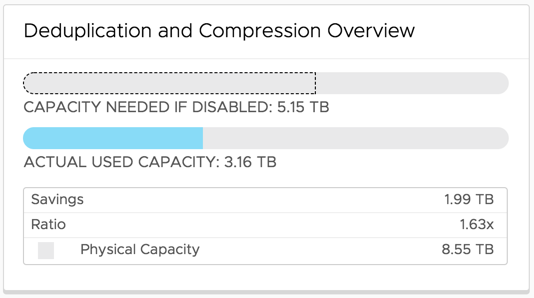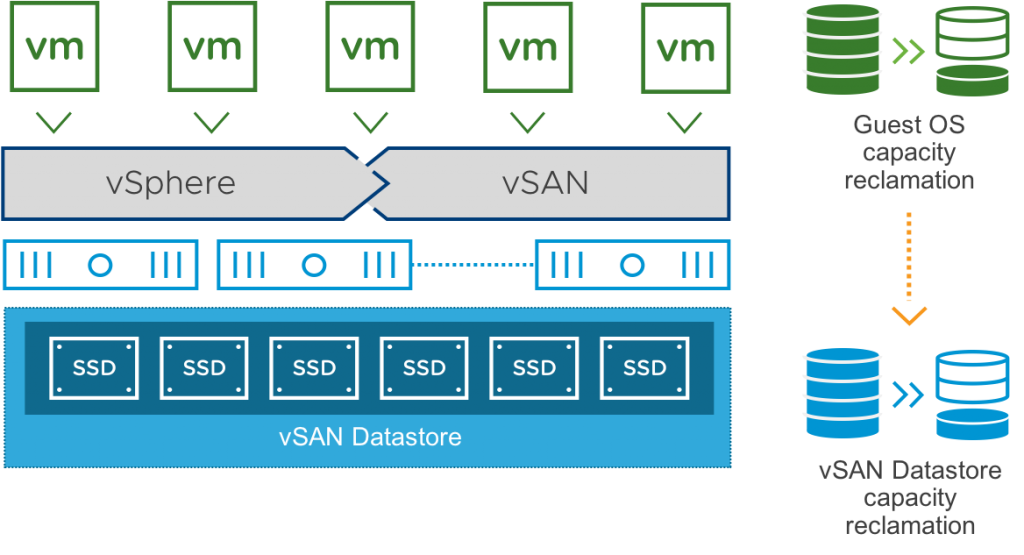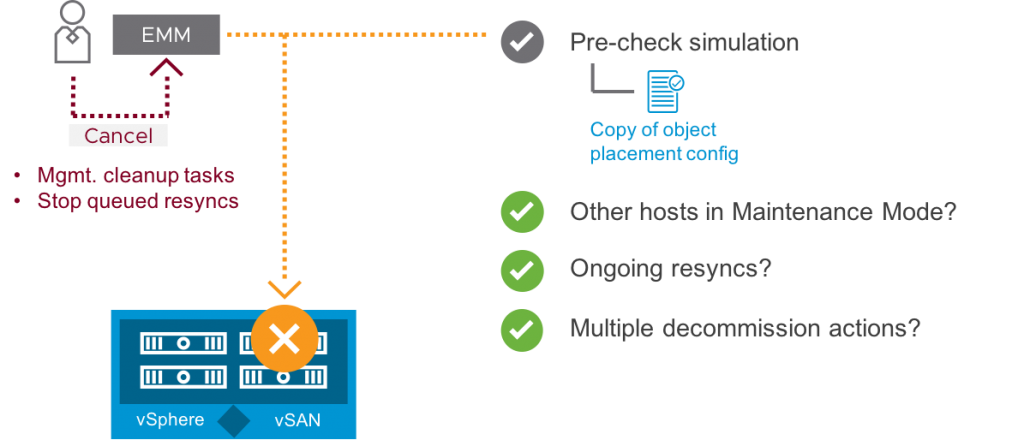VMware vSAN is the market leader in HCI. One of the many driving forces that has helped solidify this position, is the rapid and continuous pace of innovation. VMware has always given customers the power of choice, and this continues into the hybrid cloud era. VMware’s digital foundation gives customers the ability, and flexibility to build true hybrid cloud environments to best suite their use cases. VMware offers a full stack SDDC, and HCI is the starting point for those transitioning to a software-defined infrastructure.
VMware HCI, the Best Building Block for a Digital Foundation
Data centers powered by VMware vSAN offer scalability, flexibility, and manageability to meet nearly any demand, and is the cornerstone for customers looking to build private clouds and extend their multi-cloud capabilities.
 VMware vSAN is the only storage software natively integrated with the market-leading hypervisor, vSphere. This unique integration delivers optimal resource utilization for the most critical of applications.
VMware vSAN is the only storage software natively integrated with the market-leading hypervisor, vSphere. This unique integration delivers optimal resource utilization for the most critical of applications.
VMware vSAN provides industry-leading deployment flexibility with the largest HCI ecosystem. Over 15,000 private clouds, running on over 500+ ReadyNodes™, jointly certified servers, VxRail – a jointly engineered turnkey appliance, as well as two of the largest public cloud providers, Amazon and IBM. Run HCI on the hardware you prefer.
VMware uniquely provides centralized management of all your HCI deployments from edge to core to cloud from the same tools you use today, vCenter and vRealize. These can optimize your operational efficiency with a single toolset across the hybrid cloud, without having to learn any new skills.
All of these features are available today. Not tomorrow, not next quarter, not next year, today. Only VMware can deliver a true hybrid cloud to your data center now.
vSAN 6.7 U1 Makes it Easy to Adopt HCI
VMware vSAN 6.7 U1 makes it even easier to adopt HCI and build a Digital Foundation. Key areas where vSAN 6.7 U1 provides additional benefits include the simplification of day one and two operations, lowering the total cost of ownership with more efficient infrastructure, and even more rapid support and resolution with ReadyCare.
First, we are simplifying operations day one and two operations by streamlining the deployment process, improving lifecycle management, reducing disruptions during maintenance operations, and improving capacity reporting. These updates help administrators more quickly and easily deploy and extend infrastructure while minimizing disruptions while keeping the environment up to date.
Simplified Operations
Cluster Quickstart
Speed to market and configuration consistency are paramount to reduce risk, maintain uniformity, and achieve better stability and efficiency. A new “Quickstart” guided cluster creation wizard gives administrators a streamlined mechanism for deploying vSAN, and non-vSAN, clusters.
An easy to use, step-by-step configuration wizard makes creating a production-ready vSAN cluster effortless. Cluster Quickstart handles initial deployment, as well as the process of expanding the cluster as needs change.
The Cluster Quickstart wizard workflow includes these tasks and more to ease the deployment process:
- Cluster services including vSphere HA, vSphere DRS, and vSAN
- Adding hosts – Add multiple hosts simultaneously
- vSAN deployment type
- Network configuration including vSphere Distributed Switching
- Disk Group configuration
- Data Services like Deduplication & Compression / Encryption
The Cluster Quickstart wizard works great for configuring vSAN clusters added to an existing vCenter 6.7 U1 deployment, as well as a great next step after using vSAN Easy Install to bootstrap a new vCenter onto the first host in a new vSAN cluster.
The Cluster Quickstart wizard can be seen in action on StorageHub.
Driver & Firmware Updates using Update Manager
Updated in vSAN 6.7 U1, all ESXi, driver, and firmware update functions previously handled by the Configuration Assist workflow have been moved to vSphere Update Manager.

Specific OEM builds can be supported in vSphere Update Manager for 6.7 U1 because it will support the use of OEM vendor ISOs. For those needing to update environments that do not have Internet connectivity, new workflows provide guidance for adding updates to the network isolated environment.
Decommissioning and Maintenance Mode Safeguards in vSAN 6.7 U1
Since each vSAN host in a cluster contributes to the cluster storage capacity, entering a host into maintenance mode takes on an additional set of tasks when compared to a traditional architecture.
vSAN 6.7 U1 has improved the safeguards when performing maintenance and decommissioning activities on vSAN hosts. vSAN will now perform a full simulation of data movement to determine if the process of entering maintenance mode will succeed or fail before it even starts. This will prevent unnecessary data movement and provide a result more quickly to the administrator.
New warnings have been added to entering maintenance mode activities to ensure that there are no other hosts already in maintenance mode or resync activity current performing.
For cases where an administrator needs to adjust the time vSAN waits before it begins to rebuild data to reestablish compliance with storage policies, a new “object repair timer delay” setting is now in the UI.
All of these improvements are added to enhance the overall experience and predictability of host decommissioning activities like entering a host into maintenance mode.
More vRealize Operations Intelligence
In vSAN 6.7, “vRealize Operations within vCenter” provided an easy way for customers to see basic vRealize intelligence with vCenter.
New in vSAN 6.7 U1, vRealize Operations dashboards have the ability to differentiate between normal and stretched vSAN clusters, displaying appropriate intelligence for each.
An incredible number of metrics are exposed to assist with monitoring and issue remediation. vRealize Operations makes it easier to correlate data from multiple sources to speed troubleshooting and root cause analysis.
Improved Capacity Reporting
vSAN 6.7 U1 enhances capacity reporting in a few different ways. Having a better understanding of past, present, and future capacity utilization is a top-of-mind concern for administrators.
In vSAN 6.7, Administrators can easily:
- Estimate the amount of usable capacity based on a desired storage policy

- Determine the capacity required if deduplication & compression were disabled

- See the amount of capacity used historically in vSAN 6.7 U1, including changes in deduplication & compression ratios over time

Efficient Infrastructure
Next, vSAN is an even more efficient infrastructure choice. More efficient infrastructure helps in lowering the total cost of ownership. Space reclamation, enhanced networking support for some architectures, as well as better sizing tools lead to even more efficiencies with vSAN.
TRIM/UNMAP Support
Popular workloads can use less storage through the process of automatic space reclamation. The addition of TRIM/UNMAP support can automatically reclaim capacity that is no longer used, reduces the capacity needed for popular workloads without administrator interaction. TRIM/UNMAP will be supported in a variety of Guest Operating Systems, virtual hardware configurations, and virtual machine configurations.
TRIM/UNMAP will be supported in a variety of Guest Operating Systems, virtual hardware configurations, and virtual machine configurations.
Mixed MTU Support for 2 Node and Stretched Clusters
In a stretched cluster environment, the ability to isolate witness traffic using dedicated uplinks was a powerful enhancement made to vSAN 6.7. vSAN 6.7 U1 introduces additional levels of flexibility to this feature with the support of mixed MTU sizes configured for witness traffic, and the Inter-site link used for vSAN data traffic.
This allows for a user to configure vSAN to use perhaps larger frame sizes on the vSAN data network while keeping the witness uplinks going to the more affordable witness site to a more common standard MTU size. This enhancement will give additional flexibility in accommodating a wider variety of customer topology conditions and reduce potential network issues.
Updated Sizing Tools
We’re also introducing new capabilities that simplify planning to help customers size the most efficient deployment for their environment.
 |
 |
Updates to the HCI Assessment and vSAN Sizer tools work even better together to provide a more streamlined and flexible sizing and infrastructure selection process to ensure the most efficient configuration for new deployments.
Rapid Support Resolution
Faster resolution, quicker diagnosis, and simplified self-help make vSAN Supportability even better. vSAN ReadyCare has simplified the support process by reducing requirements of customers, and speeding time to resolution through faster insight and integrated self-help in vSAN.
Improved Health Check Guidance
The health check feature of vSAN continues to play a prominent role in its ability to ensure that an environment meets hardware and software configuration requirements.vSAN 6.7 U1 extends this feature even more, with a more robust way of handling multiple approved firmware levels for storage controllers. A new Unicast network performance health check and test ensures that proper continuity is achieved between vSAN hosts and will report network bandwidth results for the tests.vSAN 6.7 U1 also introduces functionality that is now accessible in the UI. Health checks can be silenced granularly, directly in the UI, as well as being able to purge inaccessible swap objects that are no longer needed.These improvements improve the effectiveness of vSAN’s ability to not only recognize issues but remediate them more quickly.
A new Unicast network performance health check and test ensures that proper continuity is achieved between vSAN hosts and will report network bandwidth results for the tests.vSAN 6.7 U1 also introduces functionality that is now accessible in the UI. Health checks can be silenced granularly, directly in the UI, as well as being able to purge inaccessible swap objects that are no longer needed.These improvements improve the effectiveness of vSAN’s ability to not only recognize issues but remediate them more quickly.
Enhanced Support Diagnostics
vSAN 6.6.1 introduced “vSAN Support Insight,” VMware’s method of automatically collecting vital infrastructure telemetry data about an environment for the VMware technical support engineers in our global support services group.
vSAN 6.7 U1 continues with these improvements, introducing fine-grained, deep level performance graphs for the explicit purpose of issue resolution. GSS engineers will have new tools for capturing critical network diagnostic data. These advances help reduce the need to request log support bundles from the hosts, and when they are absolutely necessary, will contain even more critical data for better root cause analysis. Native health checks, more self-help tools, better reactive support with vSAN Support Insight, and participation in the VMware Customer Experience Improvement program, provide for an overall enhanced support experience. VMware can rapidly understand a customer’s environment, perform root cause analysis to identify the cause of the problem, and deliver proactive support based on trends and analytics
Native health checks, more self-help tools, better reactive support with vSAN Support Insight, and participation in the VMware Customer Experience Improvement program, provide for an overall enhanced support experience. VMware can rapidly understand a customer’s environment, perform root cause analysis to identify the cause of the problem, and deliver proactive support based on trends and analytics
Summary
VMware vSAN continues to innovate at a rapid pace, making it even easier to adopt HCI and build a Digital Foundation. Simplified operations, a lower cost of ownership, and even more rapid support and resolution are just a few of the key areas that help make VMware HCI with vSAN the industry-leading HCI provider. Whether on-premises or in the cloud, only VMware can deliver a true hybrid cloud to your data center now.
Links
vCenter Server 6.7u1
ESXi 6.7u1
vSAN 6.7u1
This was originally posted on the VMware Virtual Blocks site: https://blogs.vmware.com/virtualblocks/2018/10/16/whats-new-in-vsan-6-7-update-1/





